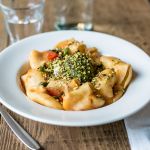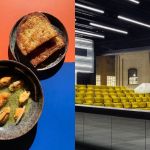
How restaurants have become the most distinctive brands in Milan
From Miscusi to Temakinho, a new generation of venues built and promoted like real brands
July 5th, 2020
The sandwiches of Burgez, the ones by Giusti, Durini, Miscusi pasta, the pizza by Pizzium (and the Cocciuto’s, of Marghe), the sushi of Temakinho. They are the new protagonists of the Milan food scene, a place where different communication strategies can be tested, causing a crack in Milan's food culture.
On the one hand, there’s the Haute Couture of gourmet restaurants and all the culinary-drinking movement frequented by the creative class of Milan (to be clear, the Sincere Places of the city) - once a traditional sector made of historic bars and trattorias -, on the other hand, the new army of branded fast-food restaurants, symbols of the new Milan’s delivery culture. Nowadays the Milan-model is facing a serious crisis, caused by the lockdown while the public opinion is finally devoting more attention to the dark side of the food delivery system, so there’s a turning point: will it be able to remain on the market or will it be the end of a fashion rose after the Expo and fueled by the spirit of a new European Milan?
Visibility and brand building are the first aspects to be taken into consideration. And Milan for this is a perfect place, a constantly evolving place where aesthetics and packaging have become a cult, and ordering dinner has become a status symbol. A world that is totally different from the places that had previously distinguished the culinary tradition of the city. The delivery system has built brands and a world of images, while traditional restaurants, who even tried to break through on social networks, have lost their visibility.
The image construction of Miscusi, Burgez, Hamerica’s or Pizzium are all focused on promoting their experience, even if everything starts from the product, always of quality and recognizable. Whether it’s a home-made pasta dish or a Chinese dumpling, the lowest common denominator of these companies is having a single flagship product. Burgez restaurants, in fact, as you can guess from the slogan on the bag (Try not to come back) sell their food as something so irresistible to push people not to go, and provocatively, invites customers with phrases like Burgez Merda. Other brands, such as Miscusi or Hamerica’s, focus more on the delicacy of the products and sweet and delicate storytelling on their Instagram profiles, with such screensaver photos of steaming dishes or hamburgers surrounded by chips. In this way, food branding becomes a phenomenon of local marketing, and brand profiles recite commercial invitations of all kinds. For these brands, the aesthetics of the spaces, whose physical context is an integral part of the brand, also becomes important. The restaurants of Miscusi follow the restaurants' style of New York’s “Little Italy”, with iron chairs and green bricks on the wall. A special design made by the Italian architect Fabio Novembre, who gave to Miscusi restaurants an iconic status, made clear for all, that match both proxemic and aesthetics.
The abundance offer of Milan is a double-edged sword: if on the one hand, the ecosystem effect creates an increasingly open and demanding customer and culture, on the other there is also the risk of disappearing. Assaggino, a local in Milan, closed in 2018; the same went for Macinata Hamburgers, but above all, California Bakery is also about to close due to bankruptcy. It’s not easy to stay up on the high levels of fast food in Milan, where the market mainly rewards quality and management. By the way, fashion is the real engine of these dynamics. In 2019, poke turned out to be the most ordered food in the world, and as a result, in Milan, there’s been a real boom. But restaurants that rely on a certain product - such as poke - can go beyond their own speciality? The strategies are different, such as Miscusi’s one, which aims at building a recognizable brand, or the Burgez’s one, which like poke, focuses strongly on the passion for hamburgers, now attesting throughout Italy. But remaining successful and competing at high levels is still difficult, and renewal is fundamental.
Panini Durini was inaugurated in 2011; Hamerica’s was founded in 2017, Miscusi in 2016, Burgez in 2015, Pizzium in 2017, Cocciuto in 2018 and in general, many other brands began to populate the spaces of the Milanese window-shops over the last five years. On the delivery apps, these names enjoy incredible visibility, and these are the ones that catalyze on them the hype of customers. But the clogged food delivery system is also creating problems. Thousands of orders have rounded up the server of many requests and riders have become automata: pick-up-travel-deliver. For this reason, riders have started to protest for their rights as workers, because in the one hand they are not recognized as such workers, and therefore do not have any insurance, while on the other hand, they denounce the absence of safety during work - have you ever tried whizzing around on your bike in the middle of traffic with a minifridge size backpack and with the need to do it as quickly as possible? The national awareness then arrived two weeks ago, when a rider at Greco-Pirelli train station was arrested for trying to get on a train with her bike, the one she uses to do her deliveries.
This has worked particularly well in Milan and ordering from those restaurants is part of a new Milanese wave, and by the way, the lockdown crisis doesn’t seem to have stopped that trend. Furthermore, in the months of the lockdown, a new conception of food delivery seems to have been born, devoted to the quality of the ingredients and the sustainability of the production cycles, with an ethical approach especially when it comes to the condition of the workers. Sergio does not want to destroy or demonize delivery services but wants to revolutionize them from the inside, in complete synergy with the restaurants available on the website.
The health emergency and the consequent lockdown have flattened the global economy and created a real crisis, but the hype towards these brands has not decreased at all. Rather, their social campaigns are still going strong, and all these brands have managed to overcome these difficult months, while many others had to close. The interest is still high because delivery is now a status, even if there will necessarily be an implicit request for renewal and adaptation, as happened to other industries and shopping habits. The real challenge for the Milan food brands will be to confirm the hype of regular customers since as the coronavirus has changed society, it could change the new trends of Milan food branding.







































































